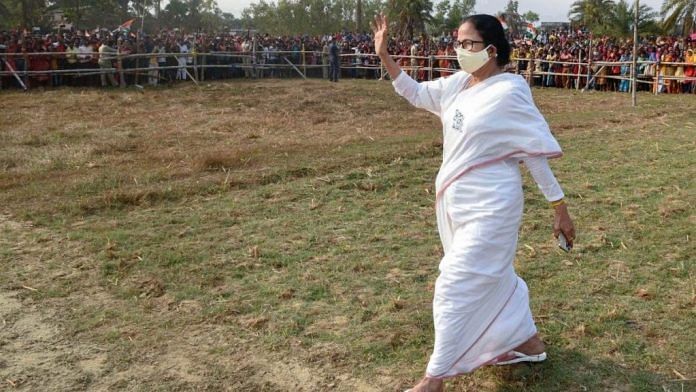Kolkata: After hours of confusion, around 11.15pm Sunday, the Election Commission finally declared that West Bengal Chief Minister Mamata Banerjee had lost Nandigram to her one-time party colleague and protege Suvendu Adhikari.
Adhikari, who moved to the BJP just weeks before the polls, won by a slim margin of 1,956 votes.
Earlier in the day, conceding defeat, Banerjee had said, “There has been a mischief played by the ECI in Nandigram. We will go to the court as the people have witnessed the horror of the ECI. How can the verdict of the people of Bengal be different in just one constituency?
“Bengal saved India, humanity and democracy. We will give free vaccines to all here and I will demand that the Centre should vaccinate 140 crore people of India free of cost. If it does not happen, I will start non-violent agitation near the Gandhi Murti.”
Calling it a landslide victory, she said, “Do not be sad about Nandigram. It is good that I now do not need to go that far.
“Everything happens for good. I bow down to the people of Bengal for this clear mandate. Everybody should now shut up. And some of the senior officials, who sided with outsiders, remember that I am watching you. I know what you did,” said Banerjee standing on a raised podium in her Kalighat residence in south Kolkata.
Banerjee, who was wheelchair-bound since 14 March after sustaining injuries during a rally in Nandigram, left her wheelchair Sunday to walk on her feet, and climbed the staircase in her residence to declare victory.
The fight for Nandigram was arguably the most fiercely contested battle with Banerjee taking on BJP’s Adhikari amid extreme polarisation.
Also read: Behind Congress’ Bengal debacle — rifts, confused messaging & abandonment by Delhi leaders
‘Most difficult fight’
The chief minister herself took charge of the election campaign in the constituency and supervised the poll-preparedness there.
Banerjee also posted a battery of senior leaders in Nandigram to oversee the poll preparations. Trinamool’s national secretary Subrata Bakshi, veteran peasant movement leader Purnendu Bose, and MP Dola Sen, among others, had camped in Nandigram for weeks.
Talking to ThePrint, Bose said, “It was the most difficult fight. There was so much misrepresentation and malicious campaign in Nandigram.”
Why Banerjee chose Nandigram
The Nandigram campaign took a communal turn with Adhikari calling the local Muslims ‘Pakistanis’, ‘Jihadis’, ‘Lungi Vahini’. The TMC retorted, terming Adhikari as ‘Gaddar’ or ‘Mir Jafar’.
To contest in Nandigram, Banerjee left her pocket borough Bhawanipore seat in south Kolkata, which she has represented for the previous two terms.
Even though many would like to simplify her action saying that she played into BJP’s hand, this seems to be a calculated and well thought-out move.
In a polarised election, Banerjee had to choose between one of the two epicentres of the state’s anti-land acquisition movements — Singur and Nandigram — which catapulted her to power in 2011.
Banerjee seems to have chosen to fight from Nandigram, probably because Adhikari had challenged her to fight him from the seat.
Banerjee was left with no choice but to accept Adhikari’s challenge. It was a battle to prove her political supremacy in the state and remind others that she still remains undisputable in Bengal.
(Edited by Debalina Dey)
Also read: In West Bengal, why Covid is likely to turn the poll turf in favour of Mamata






